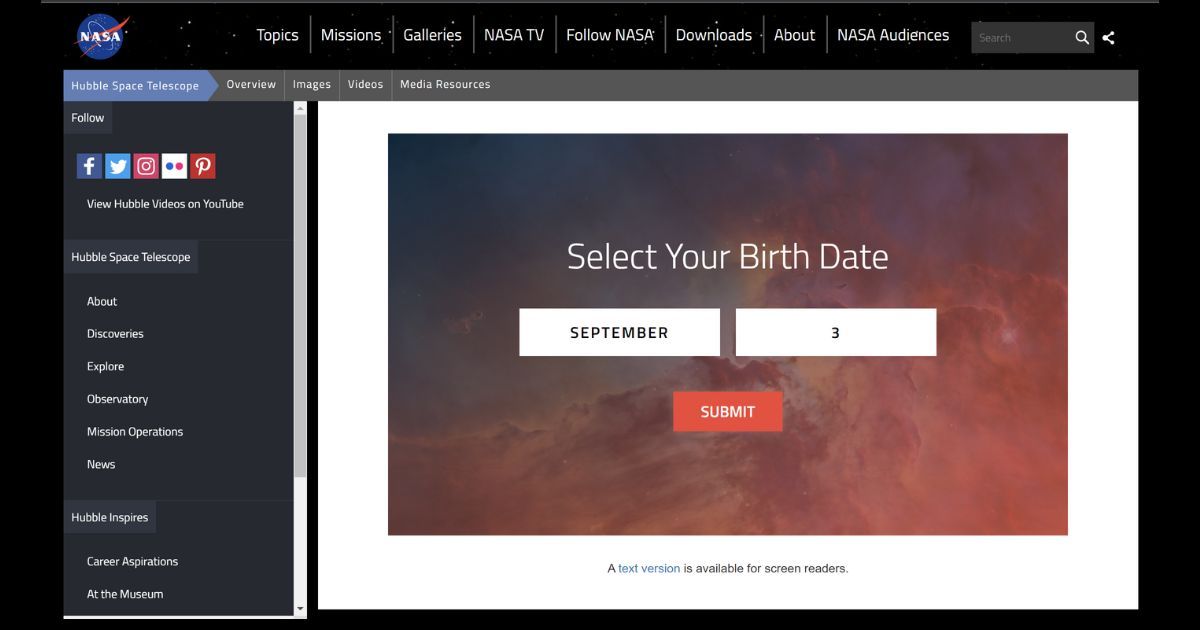
NASA is one of the well-known organizations when it comes to space explorations. NASA’s Hubble Space Telescope was launched into low Earth orbit in 1990 and remains in operation even today 一 more than 30 years. This NASA telescope in space was the largest and most versatile equipment that helps NASA capture millions of images of the cosmos.
Earlier this year, NASA announced a new tool that allows the public to check What did the Hubble telescope did on any given day in the year. Once a user enters the month and day, NASA will bring up an image and some details of the image which was taken on that particular day. The image can vary from 1991 to 2018.
Using this tool can be useful for some people, especially those who are into space and astrophysics. This can be a good gift to your friends or close ones as well. You can check out what the telescope saw on your special day. 一 it can be a birthday, anniversary, or any other special day in your life. In this guide, we will take a look at how one can make use of this tool from NASA.
Also Read: Send Your Name To Mars on NASA’s Next Space Flight to the Red Planet: Here’s How
Hubble Space Telescope: History
Hubble Space Telescope is a large, space-based observatory, which has revolutionized astronomy since its launch and deployment by the space shuttle Discovery in 1990. It is named in honour of the trailblazing astronomer Edwin Hubble, who was an American astronomer. The Hubble telescope can see and capture the universe far above rain clouds, light pollution, and atmospheric distortions.
The telescope has been in operation for over three decades now. In case you are wondering how the telescope has survived for such a long period, that’s because new, cutting-edge scientific instruments have been added to the telescope over the course of five astronaut servicing missions. Many parts have been replaced and upgraded to extend the telescope’s lifetime.
Usually, telescopes have a particular range of light that they can detect. Hubble’s domain extends from the ultraviolet (UV) through the visible (which our eyes see) and into the near-infrared (IR). This wide range has allowed Hubble to capture and deliver images of stars, galaxies, and other astronomical objects.
Hubble has made more than 1.5 million observations over the course of its lifetime. Over 19,000 peer-reviewed science papers have been published on its discoveries, and every current astronomy textbook includes contributions from the observatory. The telescope has tracked interstellar objects as they soared through our solar system, watched a comet collide with Jupiter, and discovered moons around Pluto.
How to Use NASA’s Tool to Find Out What Did Hubble See on Your Birthday
- Visit NASA’s What Did Hubble See on Your Birthday? Website
- Scroll down and select your birth date
- Select month and select date by clicking on the respective options

- Click on Submit
- The website will now display an image related to the date you have selected, a few lines about What the Hubble telescope on the day you have selected

- You can click on se full image or read more info about the same if you are interested
In case you found the result to be interesting, you can share it instantly on Facebook, Twitter, and Pinterest with one click. These social share options are present on the top left of the image.
If you click on the text version below the screen, an Excel file will be downloaded and it contains the importance of all 365 days along with the name, date and captions.
10 Things to Know About Hubble Telescope
- The Hubble Space Telescope is often referred to as HST or Hubble.
- The Hubble telescope was funded and built in the 1970s by NASA with contributions from the European Space Agency.
- The telescope was launched into low earth orbit in 1990 and it still remains in operation.
- Hubble features a 2.4-meter mirror, and its five main instruments observe in the ultraviolet, visible, and near-infrared regions of the electromagnetic spectrum.
- Hubble is the only telescope designed to be maintained in space by astronauts.
- Five Space Shuttle missions have repaired, upgraded, and replaced systems on Hubble.
- The telescope completed 30 years of operation in April 2020.
- The Hubble telescope is predicted to last until 2040.
- Hubble has made more than 1.5 million observations over the course of its lifetime
- Hubble has peered back into our universe’s distant past, to locations more than 13.4 billion light-years from Earth, capturing galaxies merging, probing the supermassive black holes that lurk in their depths, and helping us better understand the history of the expanding universe.
NASA’s Other Popular Tools
In case you are a fan of outer space and want to explore more such tools, NASA has a few good ones. We have listed five more tools below for you to explore and also learn more about the space.
This one is for young kids. NASA Space Place’s mission is built to inspire and enrich upper-elementary-aged kids’ learning of space and Earth science online through fun games, hands-on activities, informative articles and engaging short videos. With material and resources for parents and teachers, NASA Space Place has something for everyone.
This is built in collaboration with NASA, Access Mars lets you explore a 3D replica of the Martian surface (Mars). This replica replicates exactly as it was recorded by the Curiosity rover when it landed on Mars. As Curiosity has travelled across Mars, it’s taken digital photographs with two stereoscopic camera systems. By combining and analyzing these photographs, a 3D model was created and used to study Mars and plan future experiments. You can visit the website and click on Explore 360 and get started. To get a better experience, it is better to use headphones.
This Solar System Exploration website is a real-time, living encyclopedia of the robotic exploration of our solar system. This site provides reliable, accurate, up-to-date information about the planets, moons, asteroids, comets and everything else in our solar system. It also provides a historical record of deep space exploration. You can explore details about other planets here as well and all the details about the planet and the whole solar system will be shown to you.
On this website, you can experience Earth and our solar system, the universe and the spacecraft exploring them, with immersive apps for Mac, PC and mobile devices. You can explore asteroids, the solar system, earth, and explore other planets in an interactive manner. There is also an option to explore Mars 2020 with real-time data visualization. Lastly, you can take a virtual tour of the new horizon at MU69, Cassini, Voyager, Juno, and more.
This tool called “Explore with Perseverance” puts you on Mars next to NASA’s Perseverance, to see what the rover sees as it explores. You can select images right from this 3D interactive or from the list view. As the rover explores Mars, the images it takes are mapped onto the terrain to fill in the picture of the Jezero Crater landing site. This experience uses imagery from Perseverance rover cameras including its Navcams, Hazcams, and Mastcam-Z. You can use your mouse to control and move around the planet.
Also Read: How to Update Google Play Store and Apps on Android?











